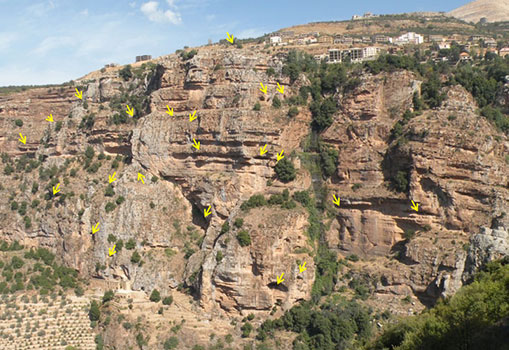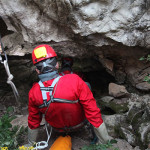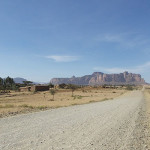Exploration of Hermitages & Shelters in the high cliffs of the Qadisha Valley.
إكتشاف نوعي في وادي قاديشا يلقي الضوء على طريقة جديدة في التنسّك
منذ أن تأسّست الجمعيّة اللبنانيّة للأبحاث الجوفيّة سنة 1988، هدفت الى استكشاف المغاور، والهوّات، والكهوف، والمحابس العاصية، في لبنان وسوريا وتركيا، وحفظها ودراستها. وجرى توثيق ونشر الأعمال التي أنجزتها الجمعيّة في أعداد مجلّة “لبنان الجوفي”، وهي مجلّة علميّة تصدر باللغتين العربيّة والفرنسيّة، وأيضًا في بعض الكتب المنشورة، أهمّها كتاب “عاصي الحدث، لبنان-تاريخ مغارة”، نشره سنة 2011 مركز فينيكس للدراسات اللبنانيّة التابع لجامعة الروح القدس-الكسليك. لقد كانت الجمعيّة اللبنانيّة للأبحاث الجوفيّة الرائدة في إجراء مسح علمي وطوبوغرافي لأهمّ المغاور، والمحابس، والمعالم التاريخيّة والدينيّة في وادي قاديشا، ونشر أبحاث عنها بعد توثيق منهجي لمعظم هذه المواقع. حاليّاً أنشأت الجمعيّة موقع الكتروني عنوانه www.cavinglebanon.com لتزويد القرّاء بنتائج هذه الأبحاث والإكتشافات.
في الآونة الأخيرة، انصبّ عمل الجمعيّة اللبنانيّة للأبحاث الجوفيّة على استكشاف بعض التجويفات (الكهوف) العاصية المنتشرة في الجُرف العامودي الصخري على ضفّتي وادي قاديشا والتي لا يمكن الوصول إليها إلاّ باعتماد تقنيّات التسلّق والإستغوار، وتبيّن لها أنّ هذه الأخيرة كانت محابس للنسّاك المتوحّدين تعود الى حقبات تاريخّية قديمة. فما هو أكيد أنّ جبل لبنان، وهي التسمية التي أُطلقت على المنطقة الممتدة من جبّة بشرّي الى جبّة المنيطرة، أقام فيه نسّاك، أغلب الظنّ منذ دخول المسيحيّة الى هذا الجبل. لكن أقدم وثيقة مؤكّدة عن وجود نسّاك في هذه المنطقة تعود لبداية القرن السادس الميلادي في مخطوط محفوظ في المكتبة البريطانيّة رقم 14542 مؤرّخ لسنة 509 ميلاديّة وقد ورد فيه ذكر “…لاونطيوس من الحدث في جبل لبنان…(وهي حدث الجبّة)” و “مار حلفاي الناسك المستحبس في جبل لبنان”.
تمّ العثور داخل هذه الفجوات الصخريّة المنسيّة، على عظام بشريّة وفخّاريّات؛ وهذه الفجوات-المحابس تقع في الأماكن التالية: الجُرف الصخري في أسفل بلدة حصرون، الجُرف الصخري بالقرب من دير مار أليشاع، الجُرف الصخري بالقرب من دير مار أليشاع، الجُرف الصخري لبلدة حدشيت والممتد حتّى دير قنّوبين.
لم يستطع الباحثون الأعضاء في الجمعيّة اللبنانيّة للأبحاث الجوفيّة تحديد تاريخ سكن الحبساء في هذه الفجوات الصخريّة، ولكنّهم توصّلوا الى إكتشافات مهمة أعطت معلومات جديدة عن طريقة التنسّك التي كان يعتمدها النسّاك في هذه الكهوف العاصية.
لهذه المحابس المكتشفة أربع ميّزات أساسيّة: صعوبة بل استحالة الولوج اليها، وضيق مساحتها وصِغرها، والإنقطاع التام عن الجماعة، واختفاء أسماء هذه المحابس مع مرور الزمن. فمثلاً إحدى هذه المحابس تتطلّب تسلّقاً على ثلاث مراحل، أي تسلّق ثلاثة جُروف متتالية للوصول الى داخل المحبسة مع استعمال الحبال الخاصة والأسافين المعدنيّة التي تُغرس في الصخر. محبسة أخرى يتطلّب الوصول اليها الهبوط على الحبل، ثم التأرجح في الجو لإلتقاط نتؤ في الصخر يساعد المستغور في تثبيت وضعيّته وتمكينه من الدخول الى المحبسة.
مساحة المحبسة ضيّقة وبالكاد يمكن أن تتسّع لشخص واحد في داخلها؛ والظاهر أنّ الناسك الحبيس عاش وحده فيها ولم يشاركه أحد في إقامته. كما أنّه في معظمها، لم يكن بإمكان الحبيس أن يتحرّك بداخلها أو يتنقّل فيها إلاّ دبّاً على ركبتيه ويديه لأنّه لا يستطيع أن يقف فيها لانخفاض السقف الصخري للفجوة. ويلاحظ في معظم هذه المحابس وجود جدار من الحجارة الموضوعة على حافة المدخل يقي الحبيس من السقوط.
في هذه الأمكنة، كان إتّصال الحبيس بجماعته محدوداً يقتصر على مساعدته لدخول الفجوة التي لا يمكن الولوج إليها إلاّ بالحبال، وتأمين ما يحتاجه من طعام بواسطة سلّة مربوطة بحبل تُدَلّى من الأعلى أو تُسحب من الأسفل حسب موقع المغارة-المحبسة. إذن يعيش هذا الناسك في عزلة تامّة بعيداً عن التجمّعات السكنيّة، ولا يشاركه أحد من جماعته الرهبانيّة الإقامة في محبسته. يدخل الحبيس إلى هذه الفجوة بصعوبات ومشقّات كثيرة ولا يخرج منها حتّى نهاية حياته. أغلب الظنّ أنَّ السريان سمّوا هذا الوادي “وادي الذخائر” بسبب عظام وثياب الحبساء التي اعتبروها ذخائر مقدّسة تركها هؤلاء بعد وفاتهم في هذه الكهوف العاصية.
هذه المحابس المكتشفة حديثاً والتي كان الإستحباس فيها ذُروة في الأوج لقهر الجسد، لا تليق لسكن البشر، فهي أشبه بأعشاش الطيور وأوكار الزواحف، وهي تختلف عن تلك الموجودة في أنحاء الوادي المقدّس إن من حيث السكن أو طريقة التنسّك؛ ففي وادي قزحيّا محابس مار بيشاي ومار ميخائيل ومار بولا وهي مناسك سهلة الدخول والخروج منها، وكان باستطاعة الحبيس العمل في الأرض المحيطة بها واستقبال المؤمنين. وفي وادي قاديشا حيث مجموعة من المحابس التي يصعب الوصول اليها، كمحبسة مار ميخائيل القريبة من دير مار أليشاع ومحبسة مار أنطونيوس في وادي حولات-حدشيت ومحبسة مار آسيا، فكان الدخول اليها والخروج منها سهلاً لوجود سلّم خشبّي ثابت (كما هي الحال في محبسة مار سمعان في عبيدات – قضاء جبيل).
تكمن أهميّة هذه الإكتشافات أنّها ربّما أحدثت تغييراً في الاعتقاد الذي كان سائداً بين العلماء والمتخصّصين بتاريخ التنسّك المسيحي في الشرق، الذين من خلال دراساتهم أظهروا أنَّ الحبساء في لبنان لم يقيموا بمفردهم في محابسهم منعزلين عن محيطهم وجماعاتهم الرهبانيّة، بل كانوا يستقبلون المؤمنين ويشاركونهم الصلاة. وقد اعتبر الأب يوحنا صادر في كتابه المنشور بالفرنسيّة سنة 1989 بعنوان “صلبان ورموز في الفن الماروني القديم” (ص.271) أنّ التنسّك في المحابس في لبنان ظاهرة إجتماعيّة مهمّة، جذبت المؤمنين لزيارة الحبيس، ما أدّى الى تجمّعهم حول المحبسة، وبناء منازل لهم بالقرب منها، والإستقرار والعمل في الأرض. فقد كانوا يعتبرون الحبيس مصدراً لتوفير الحماية لهم، والتماس البركات والنعم من الله لتحّلّ عليهم وعلى أولادهم وأرزاقهم.
الملفت في هذه المحابس المكتشفة حديثاً في وادي قاديشا أنّها تشبه الى حدّ ما المحابس العاصية في وادي إلارا بالقرب من كبادوكيا (تركيا). أمّا بخصوص الطريقة النسكية المتّبعة في هذه الفجوات الصخريّة، فإنّها تختلف عن ظاهرة التنسّك الثابت (stationnarisme-ermite stationnaire) التي بموجبها يقضي الناسك وقته واقفاً في العراء مصلّياً دون حراك، فاتحاً يديه بشكل صليب، أو عن ظاهرة التنسّك المتحرّك القائم على “الرعي” (ermite brouteur) حيث كان يخرج الناسك من محبسته دبّاً على ركبتيه ويديه يأكل العشب من الأرض (لمزيد من المعلومات عن طرق التنسّك في الشرق، راجع:
Jacques Lacarrière, Les Hommes Ivres de Dieu, ed. Points, 2008.
تبيّن من خلال هذه الإكتشافات الجديدة أنّه في وادي قاديشا وُجِدت طريقة نسكيّة مميّزة وفريدة تمزج بين ظاهرتي التنسّك الثابت والتنسّك المتحرّك دبّاً اللتين عرفهما الشرق منذ القرن الرابع الميلادي في صحراء النطرون في مصر وفي سوريا وفلسطين، ولكن ما يمّيزها أنّها محصورة ضمن مكان ضّيق ومسقوف، يدخله الحبيس مرّةً واحدة ولا يخرج منه أبداً. وبذلك يكون الإكتشاف الذي توصّلت إليه الجمعيّة اللبنانيّة للأبحاث الجوفيّة قد أظهر، وللمرّة الأولى، أنّه في وادي قاديشا انتشرت ظاهرة التنسّك المنفرد القائمة على قهر الذات والجسد بشكل قاسٍ جدّاً يعجز عن تحمّله الانسان ولا يستطيع أن يقوم به إلاّ من اختار العذاب والحياة الموحشة للإرتقاء بذاته عن هذا العالم. ولكن يبدو أنّها لم تُعتمد إلاّ خلال حقبة زمنيّة محدودة بدليل أنَّ المحابس في أواخر القرون الوسطى وطرق التنسّك اتّخذت طابعاً مختلفاً.
إنّه اكتشاف جديد قد يساهم في توسيع المعرفة العلميّة للباحثين والمتخصصّين في تاريخ التنسكّ المشرقي، ويضيف حلقة جديدة الى سلسلة تاريخ المسيحييّن في لبنان.
فادي بارودي
Specific discovery in the Valley of Qadisha sheds light on a new way of asceticism
“The Group for Subterranean Studies and Researches of Lebanon (Groupe d’Études et de Recherches Souterraines du Liban – GERSL)” was founded in 1988, and aimed to discover the grottos, the caves, the sinkholes and specially the hermitages which have difficult access in Lebanon, Syria and Turkey, in order to explore and study them. All the studies accomplished by the Group have been documented and published in “Liban Souterrain”, a scientific journal published in both Arabic and French, as well as in some books by which the most important one is “Asi-l-Hadath Lebanon, History of a Grotto” published in 2011 by Phoenix Center for Lebanese Studies at the University of Holy Spirit-Kaslik. The GERSL pioneered in the field of undergoing scientific and topographic surveys of the most important grottos, hermitages, religious and historical monuments in Qadisha Valley, and the publication of the researches after a systematic documentation of most of these sites. Nowadays GERSL developed a website (www.cavinglebanon.com) to publish the results of its works.
The main achievement of the GERSL was recently focused on exploring some holes and caves which have difficult access in the vertical rock cliff on both sides of Qadisha valley, and can be only reached by applying climbing and speleological techniques. The exploration of these sites showed that they were occupied by hermits dating back to old historical periods. What is certain is that hermits lived in Mount Lebanon, the name given to the region located between Jibbat Bsharri and Munaytra, probably since the arrival of Christianity to this mountain. But the oldest document confirming the existence of hermits in this area dates back to the beginning of the sixth century AD in a manuscript preserved at the British Library No. 14542 dated to the year 509 AD, quoting that, “… Laountios from Hadath in Mount Lebanon … (which is Hadath al-Jibbat)” and “Mar Halfay the ascetic hermit in Mount Lebanon.”
The explorers found human bones and pottery within these forgotten rock holes and caves located in the following places: the rock cliff below Hasrun, the rock cliff near Deir Mar Elisha and the rock cliff of Hadshit.
Researchers and members of GERSL could not determine the date of hermits living in these caves, but their important discoveries supplied new information about the way of asceticism adopted by hermits in these holes.
These newly discovered hermitages have a very difficult access and occupy a narrow and small space in the vertical cliff; they are completely isolated and their names disappeared with the passage of time. For example, one of these hermitages forced us to climb in three phases, namely, climbing three consecutive cliffs to get to the inside of the hermitage with the use of ropes and special metal wedges that are planted in the rock. The access to another hermitage requires descending with a rope, then swinging in the air to catch rock outcrop in order to help the speleologist to fix his position and enable access to the hermitage.
The hermitage surface is narrow and can barely accommodate one person inside. Hermit apparently lived alone inside, and due to the low rocky ceiling and small size of the cave, he could only move by crawling (moving on his hands and knees). It is noted in most of these hermitages the existence of a wall of stones placed on the edge of the entrance to prevent the hermit from falling.
The hermit communication with his religious community were only limited to help him to enter the cave that cannot be reached without ropes, and provide the food he needed by a basket tied with a rope lowered from a higher position or pulled by the hermits from his cave, depending on the location of the hermitage. So the hermit lived in complete isolation away from residential areas, and no one of his community joined him in his hermitage. He entered into this place with many difficulties and hardships and did not leave it all his life. Most probably, the Syriacs named this valley “Valley of relics” because of bones and hermits cloths which they considered sacred relics left by hermits after their death in these caves.
These newly discovered hermitages were not appropriate for living; They are more like birds’ nests different from those found in some parts of the Sacred Valley in living or asceticism. The hermitages of Mar Bishay, Mar Mikhail and Mar Bula in Qozhaya valley had an easy access and hermits were able to work in the surrounding land and receiving believers. Furthermore, in Qadisha Valley, the hermitages of Mar Mikhail close to Mar Elisha monastery, Mar Antonios in Hulat-Hadshit valley and Mar Asya had also an easy access because of the presence of a fixed wooden ladder (similar to the hermitage of Mar Semaan in Obaydat-Jbeil).
These discoveries are considered important because they would probably manage to change the dominant belief among historians in History of Christian asceticism in the East, who through their studies showed that hermits in Lebanon did not live alone in their hermitages isolated from their environment and their monastic communities, but they received believers and shared them their prayers. Father Yuhanna Sader considered in his book “Crosses and symbols in old Maronite art” (p.271) that asceticism hermitages in Lebanon was an important social phenomenon which attracted believers to visit the hermit, and with time they lived together in groups in the area surrounding the hermitage, built houses and settled to work the land. They considered the hermit a source that provided them protection and implored blessings and graces from God for themselves, their children and properties.
What is important to note while observing these newly discovered hermitages in Qadisha Valley, they somewhat resemble in their form the hermitages in Ihlara valley near Cappadocia (Turkey). As for the way of the asceticism followed in these caves, it differs from the phenomenon of fixed asceticism (stationary hermit) in which the hermit spends his time praying, motionless standing in the open air, opening his hands in the shape of a cross, or from the phenomenon of movable asceticism based on “grazing” (grazer hermit) in which the hermit went out from his hermitage on his hands and knees eating grass from the ground (for more information about the ways of asceticism in the East, see: Jacques Lacarrière, Les Hommes Ivres de Dieu, ed. Points, 2008).
These new discoveries depicted the existence of a distinctive and unique way of asceticism in Qadisha Valley mixing between the phenomenon of “fixed asceticism” and “movable asceticism” known in the East since the fourth century AD in the desert of Natrun in Egypt, Syria and Palestine. But it has a distinguished characteristic being restricted within a narrow and roofed place in which lives a hermit that enters once inside and never comes out. Thus, the discovery done by GERSL has shown for the first time that a phenomenon of lonely and distant asceticism was adopted in Qadisha Valley based on making the body suffering in a very hard way that human being could not tolerate. This asceticism could only be done by persons who had chosen suffering and isolation to rise themselves from this world. But it seems that this sort of asceticism was only adopted during a limited period of time because hermitages and ways of asceticism in the later Middle Ages took different form and aspect.
It’s a new discovery which may contribute to the expansion of scientific knowledge of researchers and specialists in the history of Eastern asceticism, and adds a new link in the chain of the history of Christians in Lebanon.
Fadi Baroudy
Active chairman of GERSL
Une découverte spécifique dans la vallée de Qadisha met la lumière sur une nouvelle forme d’ascétisme
Le Groupe d’Études et de Recherches Souterraines du Liban (GERSL) a été fondé en 1988, et son ambition majeure était l’exploration, l’étude et la classification des grottes, des cavernes, des cavités et des ermitages rupestres d’accès difficiles au Liban, en Syrie et au sud-est de la Turquie. Tous les travaux accomplis par le GERSL ont été documentés et publiés dans « Liban Souterrain », une revue scientifique publiée en arabe et en français, et aussi dans certains livres dont le plus important est « Asi-l-Hadath Lebanon, History of a Grotto» (en arabe et anglais), publié en 2011 par le centre Phoenix pour les études libanaises à l’Université Saint-Esprit, Kaslik. Le GERSL fut le pionnier dans le domaine des prospections scientifiques et topographiques des cavernes, des ermitages et des monuments religieux et historiques dans la vallée Sainte la Qadisha. En outre, les recherches menées par les membres du GERSL sont publiées et accompagnées d’une documentation de la plupart de ces sites explorés. Aujourd’hui, le GERSL a créé un site internet – www.cavinglebanon.com – pour mettre à la disposition des lecteurs les résultats de ces recherches et de ces nouvelles explorations.
Le travail principal du GERSL fut récemment concentré sur l’exploration des cavités et des cavernes d’accès difficiles dans la falaise rocheuse verticale des deux côtés de la vallée Qadisha, qui ne peuvent être atteints qu’en utilisant les techniques d’escalade et de spéléologie. L’exploration de ces sites montra qu’ils étaient les demeures des ermites et ascètes datant de périodes historiques très reculées. Ce qui est certain, c’est que les ermites habitaient la montagne du Liban, le nom donné à la région située entre Jibbat Bcharré et Mounaytra, probablement depuis l’arrivée du christianisme à cette montagne. Mais le plus ancien document manuscrit confirmant l’existence d’ermites dans cette région remonte au début du VIe siècle, conservé à la British Library (n.°14542 ) et daté de l’année 509 de notre ère, qui donne les informations suivantes : «… Laountios de Hadath au Mont-Liban … (qui est Hadath al-Jibbat) » et « Mar Halfay l’ermite au Mont-Liban».
Les explorateurs ont trouvé des ossements humains et de la poterie au sein de ces cavités oubliées et situées dans les endroits suivants: la falaise au-dessous de Hasroun, la falaise qui surplombe le monastère de Mar Elisha et la falaise de Hadchit.
Les membres du GERSL n’ont pas pu déterminer la date de l’installation des ermites dans ces cavités rocheuses, mais ont effectué d’importantes découvertes fournissant de nouvelles informations sur la forme d’ascétisme adopté par les anachorètes dans ces cavernes.
Ces ermitages découverts ont quatre caractéristiques fondamentales: ils ont un accès très difficile, ils occupent un espace étroit et petit, ils sont complètement isolés et enfin, leurs noms ont disparu avec le temps. Par exemple, un de ces ermitages nécessite une approche ardue et périlleuse, à savoir, l’escalade de trois falaises consécutives pour se rendre à l’intérieur de l’ermitage en utilisant des cordes et des coins métalliques spéciaux plantés dans la roche. L’accès à un autre ermitage nécessite un rappel sur la corde, puis faire un pendule (c.-à-d. se balancer sur la corde) pour attraper les affleurements rocheux afin de se rétablir sur le rocher pour accéder à l’ermitage.
La surface de l’ermitage est étroite et peut à peine accueillir une personne à l’intérieur. L’ascète y vivait apparemment seul, ne pouvait pas se lever et n’était pas capable de s’y déplacer que sur les mains et les genoux à cause du plafond bas de la caverne. On remarque dans la plupart de ces ermitages l’existence d’un muret de pierres placées sur le bord de l’entrée pour empêcher l’ermite de tomber.
Les contacts de l’ermite avec les membres de sa communauté religieuse étaient seulement limités à lui fournir l’aide à entrer dans la caverne qui ne pouvait être atteinte que par des cordes, et d’assurer la nourriture dont il avait besoin par le biais d’un panier attaché avec une corde à partir d’une position plus élevée ou tiré par l’ermite lui-même en fonction de l’emplacement de la caverne-ermitage ; Donc, l’ermite vivait dans un isolement complet loin des zones habitées, et personne de sa communauté religieuse ne partageait avec lui son ermitage du fait de l’étroitesse du lieu. Il entre dans cet espace avec de nombreuses difficultés et ne la quitte jamais. Les Syriaques nommaient la Qadisha « Vallée des reliques », en raison des os et habits qu’ils considéraient comme des reliques sacrées laissées par les anachorètes après leur mort dans ces « trous ».
Ces ermitages nouvellement découverts, dans lesquels l’ascétisme fondé sur la souffrance du corps connut son apogée, étaient indignes pour qu’un être humain puissent vivre. Ils apparaissaient plus comme des nids d’oiseaux et de reptiles, beaucoup plus différents des autres ermitages rencontrés dans certaines parties de la Vallée Sainte. Dans la vallée de Qozhaya, les ermitages de Mar Bishai, Mar Mikhail et Mar Boula avaient un accès facile et l’ermite était en mesure de travailler la terre aux alentours et de recevoir les fidèles. Dans la vallée de Qadisha, les ermitages sont difficiles à atteindre, comme ceux de Mar Mikhail près de Deir Mar Elisha, de Mar Antonios dans la vallée Houlat-Hadchit et de Mar Asia, mais avaient une entrée et une sortie facilitée par le biais d’une échelle de bois fixe (comme c’est le cas dans l’ermitage de Mar Semaan à Aabaydat-Jbeil).
Ces découvertes sont importantes car elles ont contribué à changer l’idée qui a prévalu entre les spécialistes de l’érémitisme chrétien dans le Moyen-Orient, qui, par leurs études ont montré que les ermites au Liban ne vivaient pas seuls dans leurs ermitages, isolés de leur environnement et leurs communautés religieuses, mais ils accueillaient les fidèles et partageaient avec eux leur prière. Le père Youhanna Sader considéra dans son livre «Les croix et les symboles de l’ancien art maronite » (p. 271), publié en français en 1989, que l’ascétisme pratiqué dans les ermitages au Liban avait formé un phénomène social important attirant les fidèles, qui venaient visiter l’ascète et s’installer aux alentours de l’ermitage, construisant des maisons et travaillant la terre. Les ermites étaient considérés comme la source qui leur assurait la protection, et l’imploration des grâces et des bénédictions de Dieu pour eux, pour leurs enfants et leurs propriétés.
Ce qui est intéressant dans ces ermitages nouvellement découverts dans la vallée Qadisha, c’est qu’ils ressemblent, de par leurs difficultés d’accès, à certains ermitages de la vallée d’Ihlara près de la Cappadoce (Turquie). Quant à la façon dont l’ascèse se pratiquait dans ces cavités rocheuses, il différait du phénomène de l’ascétisme fixe (stationnarisme, ermite stationnaire) selon lequel l’anachorète passait tout son temps à prier à l’air libre, immobile, ouvrant les mains en forme de croix, et du phénomène de l’ascétisme mobile (ermite brouteur) selon lequel l’anachorète sortait de son ermitage en se déplaçant sur les mains et les genoux « broutant » l’herbe de la terre (pour plus d’informations sur les formes d’ascétisme en Orient, voir : Jacques Lacarrière, Les Hommes Ivres de Dieu, éd. Points, 2008).
Ces nouvelles découvertes ont montré l’existence d’une forme d’ascétisme unique et distincte adoptée dans la vallée de la Qadisha regroupant les phénomènes de « l’ascétisme fixe » et de « l’ascétisme mobile » connus en Orient depuis le quatrième siècle de notre ère dans le désert de Natroun en Égypte, en Syrie et en Palestine. Mais cette forme d’ascétisme de la Qadisha avait des caractéristiques distinctes étant restreinte dans un endroit étroit et couvert dans lequel l’ermite entrait et n’en sortait jamais. Ainsi, la découverte effectuée par une équipe du GERSL a montré, pour la première fois, que le phénomène de l’érémitisme solitaire était adopté dans la vallée de Qadisha. Cette forme d’érémitisme n’était exercée que par des personnes qui avaient choisi de pousser à la limite la souffrance envers son corps et de pratiquer un isolement total et sévère en délaissant ce monde matériel afin de s’élever vers Dieu. Mais il semble que cette forme d’ascétisme ait été seulement adoptée pendant une période limitée car les ermitages et les formes d’ascétisme de la fin du Moyen Âge ont pris un aspect différent, beaucoup plus humain.
C’est une nouvelle découverte qui pourrait contribuer à élargir la connaissance des chercheurs et des spécialistes de l’histoire de l’ascétisme en Orient, et à ajouter un nouveau maillon à la chaîne de l’histoire des chrétiens du Liban.
Fadi Baroudy
Président du GERSL.









